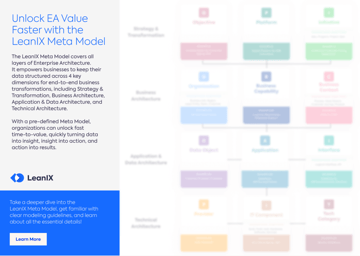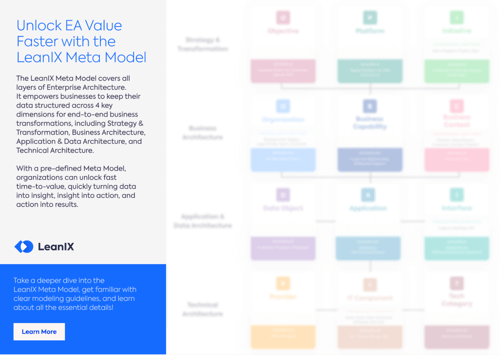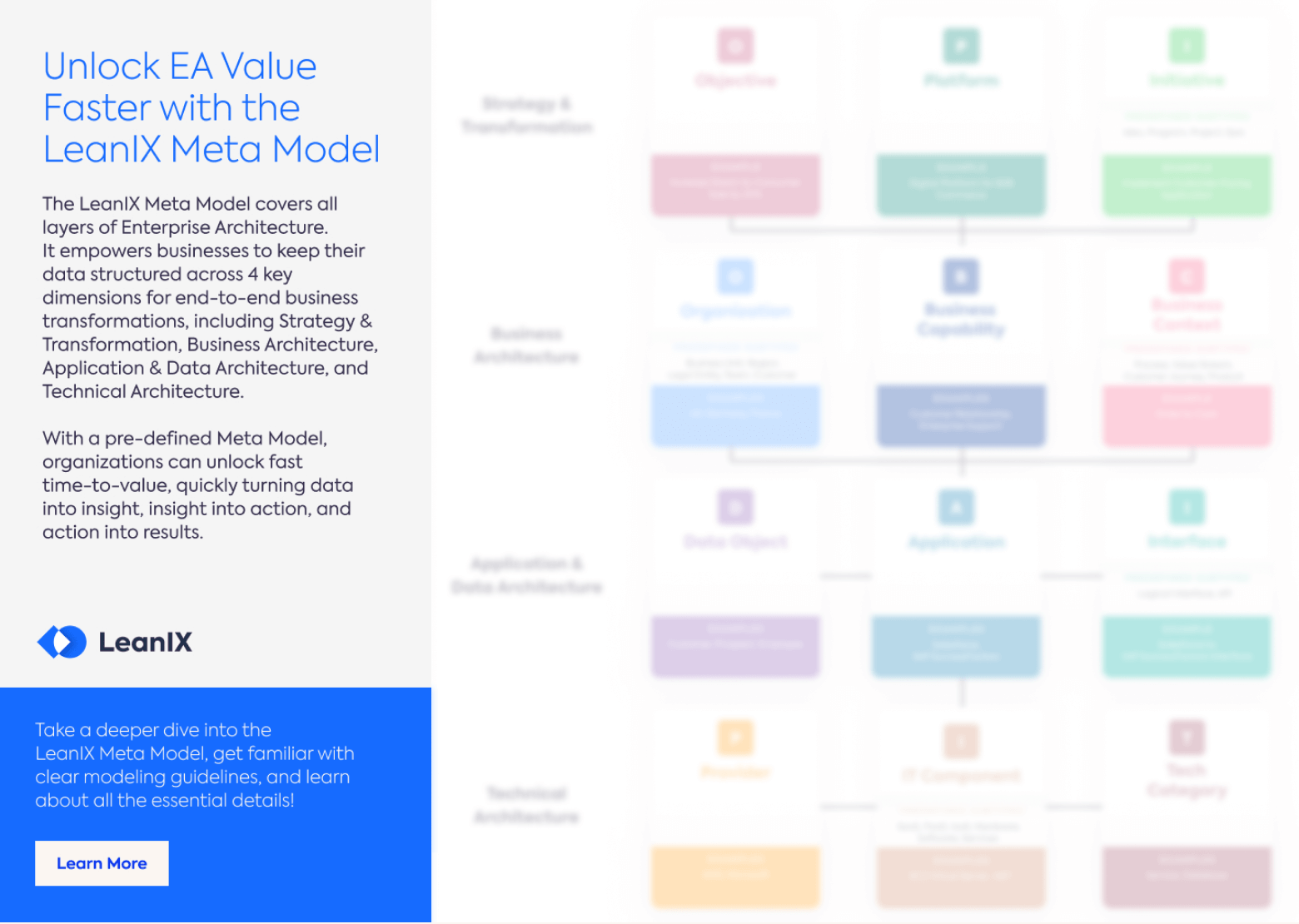Enterprise architecture frameworks list
Enterprise architecture frameworks are not one-size-fits-all; they vary greatly in their approach, methodology, and end goals.
This section provides a high-level overview of what these frameworks are and the significance of standardization within them.
1. The Open Group Architecture Framework (TOGAF)
TOGAF is one of the most popular and widely used enterprise architecture frameworks. Developed by The Open Group, this framework is designed to help organizations design, evaluate, and build the right architecture for their organization.
Core concepts
The framework is centered around the TOGAF Architecture Development Method (ADM), which provides a step-by-step approach to developing an enterprise architecture. The ADM addresses all the necessary phases, from the initial planning, through to the management and governance of the architecture once it's in place.
TOGAF's Architecture Development Method (ADM)
The ADM cycle consists of the following phases:
- Preliminary Phase: Prepare the organization for adopting TOGAF.
- Phase A: Architecture Vision: Define the scope, stakeholders, and vision.
- Phase B: Business Architecture: Develop the business architecture.
- Phase C: Information Systems Architectures, which includes data and application architecture.
- Phase D: Technology Architecture: Design the technology architecture.
- Phase E: Opportunities and Solutions: Identify delivery vehicles for the architecture defined.
- Phase F: Migration Planning: Develop a detailed implementation plan.
- Phase G: Implementation Governance: Oversee the implementation.
- Phase H: Architecture Change Management: Manage changes to the new architecture.
Supporting these phases are the TOGAF Enterprise Continuum & Tools, which provide a way to classify and store the various assets involved in EA.
Benefits
- Provides a comprehensive approach to design, planning, implementation, and governance of an enterprise information architecture.
- Is adaptable to an organization’s needs.
- Offers detailed guidance on the process of building IT architectures.
Challenges
- Can be complex to understand and implement due to its comprehensive nature.
- Requires significant commitment and resources to realize the full benefits.
- May require cultural changes within an organization to adopt and adhere to its methodologies.
📚 Related: TOGAF Detailed Guide
2. Zachman Framework
The Zachman Framework is one of the earliest and most fundamental enterprise architecture frameworks. It was created by John Zachman in 1987 and has been a cornerstone in the field of enterprise architecture for its comprehensive and descriptive focus.
It is often described as a taxonomy for organizing architectural artifacts (in other words, design documents, specifications, and models) that come into play when creating complex enterprise systems. Unlike some other frameworks that are process-oriented, the Zachman Framework is structured as a matrix.
The structure
The framework consists of a two-dimensional classification schema that reflects the intersection of six communication questions (What, How, Where, Who, When, Why) with six rows representing different perspectives (Planner, Owner, Designer, Builder, Subcontractor, and Enterprise Operations).
Key components and artifacts
Each cell in the matrix represents a specific artifact required for creating a complete picture of the enterprise architecture. These artifacts help in understanding and documenting the enterprise from different perspectives, ensuring that nothing is overlooked.
Advantages
- Provides a highly structured way of viewing and documenting an enterprise from a holistic point of view.
- Each perspective is clearly defined, which can aid in thorough documentation and analysis.
- Helps in ensuring that all stakeholder concerns are addressed.
Limitations
- The framework can be seen as overly complex and rigid.
- It does not provide a specific method for creating an enterprise architecture.
- It may be difficult to apply in fast-paced environments where agility is required.
📚 Related: Zachman Framework Detailed Guide
The Zachman Framework has significantly influenced the development of later EA frameworks, which often incorporate some of its key concepts and structures.
3. Federal Enterprise Architecture Framework (FEAF)
FEAF is an enterprise architecture framework developed by the United States Federal Government to provide a common approach for the integration of strategic, business, and technology management as part of organization-wide improvement efforts.
FEAF promotes shared development for federal processes, interoperability, and sharing of information among federal agencies and other government entities. By using FEAF, federal agencies can better align their IT resources with their missions and strategic plans, which in turn helps to serve the public more effectively.
FEAF's segmentation architecture
One of the key components of FEAF is its Segmentation Architecture, which divides the enterprise into manageable segments (or business areas) that can be addressed independently while maintaining a holistic view of the enterprise. This allows for targeted improvements and easier management of IT investments.
FEAF's Performance Reference Model (PRM)
The PRM is another integral part of FEAF, which helps to measure the performance of IT investments and their impact on strategic outcomes. It provides a common framework for understanding performance across federal agencies, enabling better decision-making and more effective management of federal IT resources.
Implementing FEAF in government organizations
Implementing FEAF can bring about significant benefits, including:
- Enhanced alignment between business and IT.
- Improved decision-making through a common taxonomy and methodology.
- Increased collaboration and sharing across federal agencies.
However, organizations may face challenges such as:
- Adjusting to a standardized way of documenting and analyzing their architecture.
- The need for significant cultural and organizational change management.
- Ensuring consistency and compliance across different segments of the enterprise.
📚 Related: FEAF Detailed Guide
In summary, FEAF provides a structured approach for federal agencies to manage their enterprise architecture. It is tailored to meet the unique needs of the federal government, facilitating better service delivery and governance.
4. ArchiMate: A Modeling Language for EA
ArchiMate, developed by The Open Group, is a comprehensive enterprise data modeling language that allows IT architects to create clear and integrated models of enterprise architecture. It is distinct from other enterprise architecture frameworks but is often used in conjunction with them, like TOGAF, to enhance the visualization of architecture.
ArchiMate provides a uniform representation for diagrams that describe enterprise architectures. It offers an integrated architectural approach that describes and visualizes the different architecture domains and their underlying relations and dependencies.
ArchiMate's Layered Approach
The language is structured around three main layers:
- Business layer: which offers products and services to external customers, which are realized in the organization by business processes performed by business actors.
- Application layer: which supports the business layer with application services that are realized by (software) applications.
- Technology layer: which offers infrastructural services needed to run applications, realized by computer and communication hardware and system software.
These layers are supported by additional aspects such as motivation and strategy, which help in aligning the architecture with the business goals.
Integrating ArchiMate with other EA frameworks
ArchiMate is designed to coexist with other EA frameworks. For instance, TOGAF's ADM can be used to manage the development lifecycle of an enterprise architecture, while ArchiMate can be used to describe and visualize the various phases and components within that lifecycle.
Use cases and application of ArchiMate:
ArchiMate is used by organizations to:
- Describe the structure and operation of business processes, organizational structures, information flows, IT systems, and technical infrastructure.
- Bring clarity to complex architecture descriptions to aid in better understanding and communication.
- Support analysis and decision-making with visual representations of enterprise architecture concepts.
📚 Related: ArchiMate Detailed Guide
The effective use of ArchiMate as a modeling language can greatly enhance the clarity and impact of an organization's enterprise architecture efforts, making it a valuable tool in the architect’s toolkit.


/EN-TOGAF-Poster_Resource_Page_Thumbnail.png?width=400&height=283&name=EN-TOGAF-Poster_Resource_Page_Thumbnail.png)

/EN/Reports/IT%20Sustainability%20Report-Thumbnail-780x546-EN.png?width=260&height=171&name=IT%20Sustainability%20Report-Thumbnail-780x546-EN.png)
/EN/White-Paper/Insight_Communication_Engagement_How_EA_Supports_Change_Management_EN-thumbnail.png?width=260&height=171&name=Insight_Communication_Engagement_How_EA_Supports_Change_Management_EN-thumbnail.png)
/EN/White-Paper/5-critical-steps-to-change-management-in-erp-transformation-thumbnail.png?width=260&height=171&name=5-critical-steps-to-change-management-in-erp-transformation-thumbnail.png)
/ea-success-kit-cover.png?width=400&height=283&name=ea-success-kit-cover.png)


/EN/Reports/Thumbnail_MQ2021%20(1).jpg?width=430&name=Thumbnail_MQ2021%20(1).jpg)
